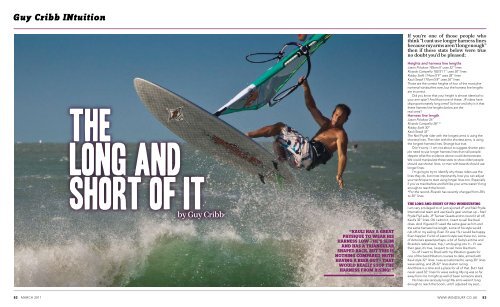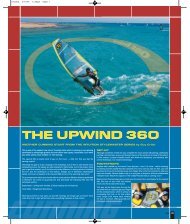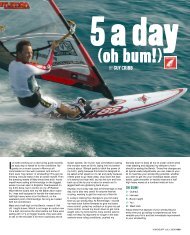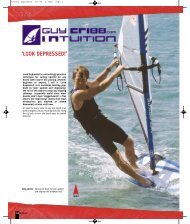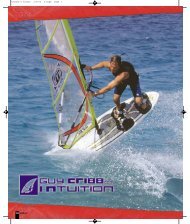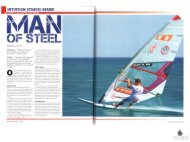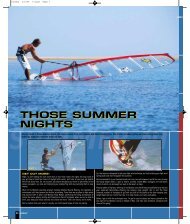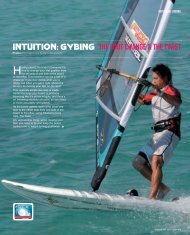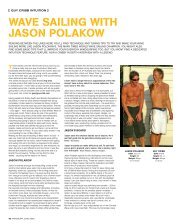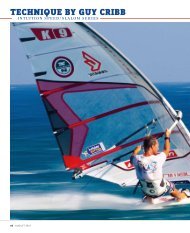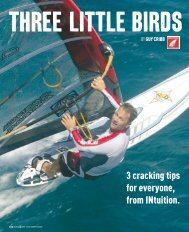Guy Cribb INtuition
Guy Cribb INtuition
Guy Cribb INtuition
Create successful ePaper yourself
Turn your PDF publications into a flip-book with our unique Google optimized e-Paper software.
<strong>Guy</strong> <strong>Cribb</strong> <strong>INtuition</strong><br />
The<br />
long and<br />
short of it<br />
by <strong>Guy</strong> <strong>Cribb</strong><br />
“Kauli has a great<br />
physique to wear his<br />
harness low – he’s slim<br />
and has a triangular<br />
shaped back. But this is<br />
nothing compared with<br />
having a beer gut – that<br />
would really stop the<br />
harness from rising! ”<br />
If you’re one of those people who<br />
think “I cant use longer harness lines<br />
because my arms aren’t long enough”<br />
then if these stats below were true<br />
no doubt you’d be pleased:<br />
Heights and harness line lengths<br />
Jason Polakow 185cm/6’ uses 32” lines<br />
Ricardo Campello 182/5’11” uses 30” lines<br />
Robby Swift 174cm/5’9” uses 28” lines<br />
Kauli Seadi 170cm/5’8” uses 26” lines<br />
Those are the correct heights of four of the most phenomenal<br />
windsurfers ever, but the harness line lengths<br />
are incorrect.<br />
Did you know that your height is almost identical to<br />
your arm span? And that none of these JP riders have<br />
disproportionately long arms? So how and why is it that<br />
these harness line lengths below are the<br />
real ones?<br />
Harness line length<br />
Jason Polakow 26”<br />
Ricardo Campello 28” *<br />
Robby Swift 30”<br />
Kauli Seadi 32”<br />
The Neil Pryde rider with the longest arms is using the<br />
shortest lines. The rider with the shortest arms, is using<br />
the longest harness lines. Strange but true.<br />
Don’t worry – I am not about to suggest shorter people<br />
need to use longer harness lines than tall peopledespite<br />
what the evidence above could demonstrate.<br />
We could manipulate these stats to show older people<br />
should use shorter lines, or men with beards should use<br />
longer lines.<br />
I’m going to try to identify why these riders use the<br />
lines they do, but most importantly, how you can adjust<br />
your technique to start using longer lines too. Especially<br />
if you’ve tried before and felt like your arms weren’t long<br />
enough to reach the boom.<br />
*For the record, Ricardo has recently changed from 28‘s<br />
to 30” lines.<br />
The Long and Short of Pro Windsurfing<br />
I am very privileged to of just rejoined JP and Neil Pryde<br />
International team and use Kauli’s gear and set up – Neil<br />
Pryde Fly2 sails, JP Twinser Quads and to round it all off,<br />
Kauli’s 32” lines. OK I admit it, I want to sail like Kauli<br />
does. And I figured if I used the same gear as him and<br />
the same harness line length, some of his style would<br />
rub off on my sailing. Even if it was 1% I would be happy.<br />
Even happier if a bit of Jason’s style was there too, some<br />
of Antoine’s speed perhaps, a bit of Swity’s airtime and<br />
Ricardo’s radicalness. Yup, I am buying into it – if I use<br />
their gear, it’s true, I expect to sail more like them.<br />
So off I went to Brazil with my <strong>INtuition</strong> guests for<br />
one of the best <strong>INtuition</strong> courses to date, armed with<br />
Kauli style 32” lines. I was accustomed to using 30” lines<br />
wave sailing, and 28-32” lines slalom racing.<br />
And there is a time and a place for all of that. But I had<br />
never used 32” lines for wave sailing. My rig was so far<br />
away from me it might as well of been someone else’s.<br />
His lines are seriously long! My arms weren’t long<br />
enough to reach the boom, until I adjusted my seat....<br />
82 MARCH 2011 www.windsurf.co.uk 83
<strong>Guy</strong> <strong>Cribb</strong> <strong>INtuition</strong><br />
I might be wrong, but I think they use their lines<br />
because:<br />
Jason – has been sailing for decades, revolutionized<br />
wave sailing and pushes the boundaries of<br />
big wave riding further and further every year. If<br />
you see him sail he’s usually up to his thighs under<br />
water on boards that are well and truly ‘sinkers’<br />
wobbling around for ages before he catches the<br />
next wave, which he then proceeds to destroy<br />
with an aggression and style that frankly is second<br />
to none. He’s upright over the board and is getting<br />
the most out of his relatively small sail for the<br />
conditions. Rather like windsurf racing, the harness<br />
lines tend to be shorter in lighter winds when<br />
you don’t need to be so far from the sail. It’s how<br />
he does it. If he returned to international competition<br />
and had to sail in side onshore choppy<br />
venues performing jumps etc, I think we’d see his<br />
lines naturally grow.<br />
Ricardo – Ric was firstly a surfer in Brazil, then<br />
in his teens became a windsurfer, arguably the<br />
most talented of our time. The triple freestyle<br />
world champion took the windsurfing rule book<br />
and ripped it to shreds, defying laws of physics<br />
and sailing to basically invent freestyle. He’s now<br />
combined them to become Vice- World Wave<br />
Champion 2010. During that year he moved from<br />
28” lines to 30” lines and prefers them whether<br />
he’s crossing the choppy waters of his home sport<br />
Margarita, or going for triple forward loops in<br />
Gran Canaria – the only man insane enough to try<br />
them.<br />
Swifty – former world youth champion racer<br />
turned big wave surfer (he’s a true Jaws local)<br />
and outstanding wave sailor- top five in the world<br />
for many years now, loves the 30” lines whether<br />
he’s slalom racing or wave sailing. It distances<br />
Longer lines are easier to hook in and out of, allowing<br />
a smooth transition from blasting to turning<br />
him from the rig for control and keeps him low to<br />
spring into radical manouvers.<br />
Kauli – the Brazil nut brought a new wave of radical<br />
innovation of equipment development, a surfing<br />
style that was tighter and more tweaked than<br />
anyone before and has revolutionised jumping<br />
and riding in the world cup. Kauli uses long, long<br />
lines, he could almost swing in them. His boom is<br />
far from high, in fact his sail design has a radically<br />
low clew and average height boom. His lines allow<br />
him to sail incredibly low down, coiled like a cat<br />
about to spring into action.<br />
Boom height<br />
As these four riders have a disparity in height<br />
of 15cm they also have different boom heights<br />
– Jason’s generally being about 5cm higher than<br />
Kauli’s, Swifty’s and Ric’s who all use basically the<br />
same position – half way up the cut out on Neil<br />
Pryde sails.<br />
But the one thing they all do slightly differently,<br />
that ultimately solves the mystery of why the man<br />
with the shortest arms uses the longest harness<br />
lines is this –<br />
Harness Height<br />
Kauli’s harness is lowest, then Swifty’s then Ric’s<br />
then Jason’s. They are all low, but Kauli’s remains<br />
low, and if it slides up, he pushes it back down.<br />
Kauli has a great physique to wear his harness<br />
low – he’s slim and has a triangular shaped back.<br />
But this is nothing compared with having a beer<br />
gut – that would really stop the harness from rising!<br />
Position your harness tightly around your belt<br />
area, beneath your gut, for be results.<br />
This lower hook position changes the angle of<br />
the lines from boom to you when planing. They<br />
32” lines in control with triple<br />
Wave World Champ Kauli Seadi<br />
point more downwards, and less horizontally.<br />
This basically means your weight swings from the<br />
boom more, increasing mast foot pressure which<br />
is great in large doses for every aspect of your<br />
windsurfing.<br />
Girls<br />
The hour-glass shape of a woman has many benefits<br />
and attractions, but it is not a good shape<br />
for wearing a waist harness. If you put the harness<br />
on the widest point, naturally it is going to slide<br />
up into the narrower area, before finally becoming<br />
jammed under your ribs. It’s not comfortable<br />
and it is very poor for your windsurfing as once<br />
the harness has risen the pull of the lines is more<br />
horizontal than vertical, and as such no longer<br />
naturally suspends your weight from them, but<br />
puts all your weight on your feet rather than the<br />
mast foot. No wonder it’s hard to plane.<br />
As an intermediate to advanced windsurfer it<br />
is paramount that you maintain good mast foot<br />
pressure/downforce on the board, for control.<br />
There are many girls who have overcome these<br />
‘high hook’ problems with extensive time on the<br />
water, a straighter body shape and by adjusting<br />
their boom heights higher than normal.<br />
However girls with the wide hips should definitely<br />
try seat harnesses. I have changed so many<br />
guests windsurfing for the better, and one of the<br />
most instant results is getting girls to try seat harnesses.<br />
It turns on the power, acceleration, top<br />
speeds and jumps instantly. Whether they stick<br />
with the seat harness or return to a waist harness<br />
is irrelevant- the fact that they have felt the benefit<br />
of using the lower hook is enough, they all now<br />
understand the importance of pushing their harness<br />
down if it slides up.<br />
Who should use longer lines, and<br />
how long should they be?<br />
If freestyle, wave sailing or racing is not your thing,<br />
long lines still might be.<br />
The benefits of longer lines are mostly:<br />
- Easier and smoother to hook in and hook outwhether<br />
you are going for a triple loop, a carve<br />
gybe, or not planing, smoothly unhooking is<br />
crucial to maintain board control.<br />
- Improved control when overpowered by being<br />
further away from the rig with a lower centre of<br />
gravity.<br />
- Increased control in choppy water by having<br />
your legs more horizontal.<br />
- Improved range of rig movement, helping<br />
pumping for example, and getting the rig<br />
forwards for early planing. (I should mention<br />
if there is one draw back from longer lines it<br />
slightly reduces your early planing- easily overcome<br />
through improved technique or raising<br />
your boom.)<br />
- Increased wind range of your sail.<br />
So if you think any of these features might help<br />
your windsurfing, join the world’s best sailors and<br />
their decisions to use longer lines. I get my very<br />
shortest guests (>50kgs) to use 26” lines, and most<br />
other guests to use 28- 30“ lines. Only extremely<br />
tall or competent windsurfers are using 32” lines.<br />
Be warned- Neil Pryde and North harness lines<br />
have the correct measurements. Da Kine harness<br />
lines are notoriously short! So if buying Da Kine’s<br />
go for 34” lines as they are the equivalent of other<br />
brands 30s!<br />
If measuring them yourself – use this image as<br />
a guideline – these were my 32” lines earlier this<br />
month.<br />
32” lines in the hands of <strong>Guy</strong> <strong>Cribb</strong><br />
Ass – the hole of the truth<br />
It is drilled into beginner windsurfers not to stick<br />
their ass out, for good reason.<br />
This sticks with windsurfers as they try to<br />
progress, but the truth is as soon as you start using<br />
the harness, you’ve got to start sticking your ass<br />
out. Reason being, when you stick your ass out,<br />
the harness, that is positioned around your waist<br />
(belt height) moves away from the boom. With the<br />
lines connected this increases the tension in them,<br />
taking it off your arms. Fact. Any <strong>INtuition</strong> guest<br />
Massive range of rig movement. (Yes, there are more<br />
amusing captions for this image, but it does show the<br />
agility such long lines gives you.)<br />
will tell you what a massive difference it makes to<br />
your stance actively pushing your ass out. You can<br />
put the theory to the test this minute – wherever<br />
you are – please stand up:<br />
- Put your arms out in front of you as though<br />
holding the boom.<br />
- Imagine you’re wearing a harness and the hook<br />
is belt height.<br />
- Push your ass out to increase the distance<br />
between boom and harness hook- therefore<br />
increasing harness line tension.<br />
- Now lean your shoulders back – which is what<br />
so many amateurs will tell you to do, and note<br />
how your harness hook becomes closer to the<br />
boom, decreasing tension in the lines/putting<br />
more weight on your arms. Disaster.<br />
There is a time and a place to have your shoulders<br />
back – but it’s not when you’re trying to increase tension<br />
into your harness, whether beginner or expert.<br />
When I’m sailing I am actively trying to increase<br />
harness line tension, not just with my body weight<br />
but with my strength pushing my legs straighter/<br />
pushing my ass out. A by-product of my ass going<br />
out is my arms bending, so I often find my elbows<br />
are bent, even using 32” lines.<br />
Low hook<br />
It is crucial your harness is worn like a trouser belt<br />
and not like a bra. OK, after falling off a few times<br />
it will rise, but you need to push it back down, or<br />
grow a suitable beer gut.<br />
To develop your ability to use longer lines and/<br />
or generally improve your windsurfing, wear your<br />
harness very low (and keep it low) then push your<br />
ass out.<br />
Here’s a young Brazilian dude borrowing my<br />
gear in Jeri – prob about 15 years old, 5’8”, 45<br />
kilos demonstrating good stance and remarkably<br />
comfy on the 32” lines.<br />
I asked John Skye what he uses for wave sailing:<br />
“I have been using 34’s for the last few years.<br />
Largely because as you said, once you tried longer<br />
lines, its really hard to go back, feels wrong! The<br />
main benefits I saw were in one handed jumps,<br />
like Backies.. you keep your distance from the rig,<br />
which I think gives more control. Also when its<br />
crazy windy I think its good to be away from the<br />
rig. I think maybe 34’s are a touch too long for me<br />
and sometimes I think I should try 32’s, but for the<br />
moment I am not changing. Drawbacks... maybe<br />
in light winds its better to be a bit more upright,<br />
but I often knock the boom up a couple of centimetres<br />
with a 5.8 anyway.”<br />
Summary<br />
Put your harness on around your pelvis/belt<br />
height.<br />
Tighten your harness when wet.<br />
Keep your harness low.<br />
Try longer lines.<br />
Push your ass out when sailing to increase harness<br />
line tension.<br />
Use a <strong>Cribb</strong> Sheet to position your harness lines<br />
using science not hope.<br />
<strong>Guy</strong> <strong>Cribb</strong> is a brand ambassador and rider for<br />
JP-Australia, Neil Pryde, holiday Extras, Animal,<br />
Adidas Eyewear and Pol Roger champagne.<br />
<strong>Guy</strong> is the Godfather of <strong>INtuition</strong> and the world’s<br />
leading windsurfing coach.<br />
www.guycribb.com<br />
Riding the world by storm.<br />
Copyright <strong>Guy</strong> <strong>Cribb</strong> 2011<br />
84 MARCH 2011<br />
www.windsurf.co.uk 87


